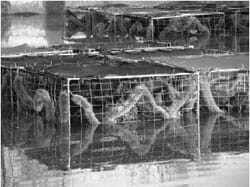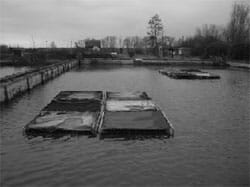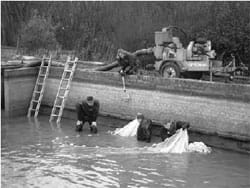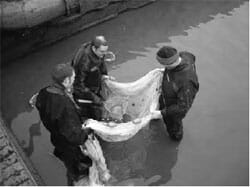Over the last 30 years the number of cormorants over-wintering in Britain has increased substantially. The latest estimates suggest there are now around 30,000 wintering birds in the country, many of which are present at freshwater sites.
 |
| Fish refuges in situ (as ponds are filling) at a trial site showing the main design features – overhead shading, ‘structure’ for the fish to hide in and mesh to keep cormorants out. |
 |
| Experimental ponds at Fobney showing the control (left) and refuge (right) ponds. The refuges are underwater once the ponds have filled. |
During the winter, cormorant numbers increase significantly at inland fisheries. This is the time when, due to low water temperatures, fish swim more slowly and the amount of aquatic vegetation used as cover by the fish is greatly reduced. It is believed that such cover plays an important role in allowing fish to escape detection by predators and hence for them to avoid being eaten. Increasing the amount of cover for fish in winter through the addition of artificial refuges (such as that shown) may therefore be an effective way of reducing the availability of fish to cormorants. It is thought that a decrease in their foraging success may make sites less attractive, leading to a reduction in use by feeding birds.
 |
Defra-funded research being carried out by Cefas, in collaboration with the Central Science Laboratory (CSL) and with support from the Environment Agency, is providing clear evidence that refuges can protect fish and reduce the foraging efficiency of cormorants. For example, in a series of four trials conducted in 2003 and 2004, two identical adjacent ponds, one with refuges and the other without, were stocked with equal numbers of fish (roach, perch and carp) and bird numbers and behaviour were then monitored closely. After 4 to 6 weeks, the ponds were drained and the surviving fish recovered. The results were consistent in all four trials, and are summarised in the table below.
| Parameter | Observed effect* (average of 4 trials) |
| Cormorant dive duration | Increase by 21% |
| Prey capture rate | Decrease by 69% |
| Successful foraging bouts | Decrease by 51% |
| No. of cormorants | Decrease by 72% |
| Weight of fish consumed | Decrease by 79% |
| Weight consumed per cormorant | Decrease by 67% |
| *Observed effect = measurement for pond with refuge relative to measurement for control pond. | |
Cormorant dive duration in the refuge pond increased and the foraging efficiency of the birds (prey capture rate and the proportion of successful foraging bouts) decreased significantly. In effect, the birds were working harder for fewer captured prey. As a result, birds found the refuge pond less attractive and used it less; on average, there were 72% fewer cormorant visits to the refuge pond than the control pond over the trials. The effect of these changes was to reduce the overall fish losses in the refuge pond by almost 80% and, when adjusted for numbers of bird visits to the respective ponds, this amounted to an average reduction of 67% in the weight of fish consumed per cormorant visit for birds feeding on the refuge pond. This clearly demonstrates that, where alternative foraging sites are available, the presence of refuges can dramatically reduce the quantity of fish eaten by cormorants at a site.
 |
| Recovering fish from the trial ponds as the water is drained away |
It is recognised that the potential benefits of using refuges are likely to vary with the fish species present and from site to site. Initial evaluation suggests that refuges might be most suitable for smaller shoaling species such as roach, perch, rudd and small bream, but a range of other freshwater species may also benefit. The size of a fishery will also be important in deciding whether fish refuges are a practical option. Refuges are likely to be most effective in smaller stillwater fisheries, and costs and practicalities may preclude extending the technique to large water-bodies.
Refuges are increasingly being used by angling clubs and fishery owners, and initial feedback from anglers at a range of sites where refuges have been deployed has been very positive. While some anglers felt that it was too early to assess whether there had been benefits, half of those consulted felt catches had got better and almost three quarters considered that fish stocks had improved, with better survival, more smaller fish present and with less adverse impact of cormorants on fish behaviour. Many anglers also reported that catches around fish refuges were good and that refuge structures were often targeted as favoured angling ‘marks’.
 |
| Counting and measuring the fish recovered. |
Further information on cormorants, including a more detailed advisory leaflet on fish refuges can be found on the Defra website: http://www.defra.gov.uk/wildlife-countryside/vertebrates/
June 2007

